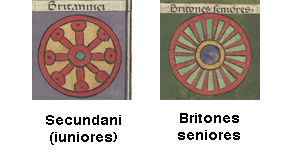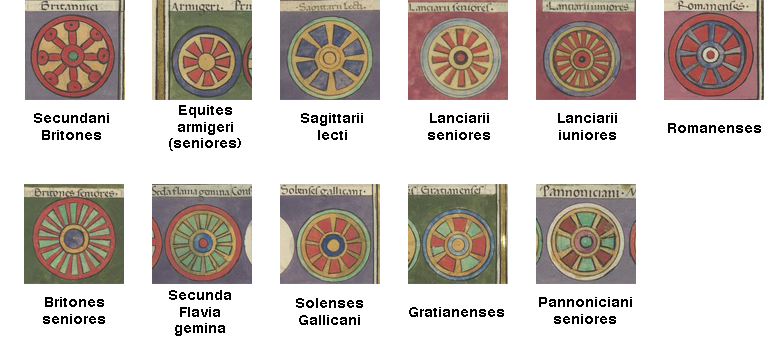
This page created 23 March 2014, and last modified: 15 November 2015 (commentary about British wheels added)

The 18th of the 32 legiones comitatenses listed (98/9.115 in Ingo Maier's numbering scheme) in the Magister Peditum's infantry roster is the Legio Secundae Britannicae siue Secundani; it is assigned (102/5.136) to the Magister Equitum's Gallic command as the Secundani Britones. Its shield pattern (96#8), under the label (96.h) Britannici, is shown in various manuscripts as below:

Note that in Seeck's edition (OC.V.241), Secunda Britannica is all the unit is called, with the other parts of the title being bracketed for deletion, changing "the Legion (called) II Britannica or The Second" into just "II Britannica".
The shield pattern shows a yellow ground, overlaid with what is clearly a wagon wheel, with a red tyre and hub, plus 8 red spokes; the colour of the axle/boss varies with the manuscript; green in O, P; white in M; red in M; yellow in B. Many other units in the Notitia have 8-spoked or rayed patterns (e.g. the Pannoniciani seniores (98/9.25), but none look so clearly like an actual wheel as does that of Legio II Britannica.
In addition to being assigned to the Magister Equitum's Gallic command, we see two other units listed in Britain with very similar names: a Secundani iuniores (102/5.208) under the Comes Britanniae and a unit commanded by a Praefectus legionis secundae Augustae (132.8), under the Comes litoris Saxonici per Britanniarum. The later, apparently stationed at Rutupis (i.e., Rutupiae, modern Richborough in Kent) is derived from Legio II Augusta. This legion dated back to Octavian (who was later styled the emperor Augustus, hence the unit's epithet), and was one of the units involved in the invasion of Britain in 43 AD; it then remained in Britain for over three and half centuries. The archaeological evidence implies that the fort at Richborough is a mere one-tenth the size of the one that the Legio II Augusta occupied in earlier times at Caernarvon, which might suggest that the legion stationed there was much diminished in size. However, the number of coins found at Richborough dating to ca. 400 AD is significantly greater than at any other British archaeological site, which would attest to its continued importance at the time the Notitia was first compiled; after all, what is actually recorded in the Notitia are the stations of officers, and not units as such; so it may well be that just the headquarters of the unit was at Richborough, while most of its men were billeted elsewhere.
Legio II Augusta, or at least a detachment thereof, should also be equated with the Secundani iuniores, since the force of Comes Britanniae seems to have been formed from British garrison units previously under the Comes litoris Saxonici per Britanniarum and the Dux Britanniarum; see further discussion here.
An equation of the Secunda Britannica with the Secundani Britones was questioned by Hassal, since Britones sounds more like a tribal name than a geographical one, implying non-legionary status. However, this is presumably because Hassel was working from Seeck's edition, or an abridged version of it, and did not have access to the original manuscripts: that the Legio secunda Britannica is clearly said to be also known as the Secundani in the Notitia effectively removes this objection; moreover, Britones and Britannici are used interchangeably for the names of other British units in the Notitia as well. Given all these names, that the Gallic detachment was called the Legio secundae Britannicae iuniores is not beyond the realms of possibility.
The name Secundani iuniores implies a seniores counterpart. No unit called Secundani seniores is to be found in the Notitia, but there is a legion called the Britones seniores (21.6), under the Magister Militum per Illyricum. As this unit clearly has a British connection, it may have originated as a detachment of Legio II Augusta, as the seniores counterpart to a iuniores that stayed behind. This is reinforced by examining its shield pattern. It is not closely similar, as the comparison below, using the appropriate Paris (P) manuscript pictures, shows, but it does share a radiating spoked design in red (but see below for a counterargument).

However, since Legio VI Victrix carried the title Britannica as a result of heavy fighting in Scotalnd in the early 3rd century, in the form of Legio VI Victrix Pia Fidelis Britannica, there is also a possibility that it was this unit that was the parent of the Britones seniores. And finally, Legio XX Valeria Victrix, while not having seemingly been called something like Britones or Bitannica, seems to have left no record of its existence in Britain during the 4th century. It may be it was removed from Britain in toto, and perhaps part of it later became the Britones seniores, as opposed to e.g. being disbanded in the aftermath of Constantius Chlorus' recovery of the province, or renamed something else. See under the Dux Thebaidos for further speculations about the British legions.
As noted above, both Legio II Britannica and the Britones seniores share a wheel-like motif. Other wheel-type pattens in the Notitia are those of the
Lanciarii seniores, one of the legiones palatina under the Magister Militum Praesentalis I,The patterns can be compared examining the following examples taken from the Paris manuscript:
Lanciarii iuniores, one of the legiones palatina under the Magister Militum Praesentalis II,
Secunda Flavia gemina, one of the legiones comitatenses under the Magister Militum per Thracias,
Solenses Gallicani, another of the legiones comitatenses under the Magister Militum per Thracias,
Gratianenses, an uncharacterised unit under the Magister Militum per Thracias,
Equites armigeri (seniores), one of the vexillationes comitatenses in the Magister Equitum's Gallic command,
Pannoniciani seniores; one of the legiones palatina in the Magister Peditum's Italian command, and the
Romanenses, one of the pseudocomitatenses units in the Magister Equitum's Gallic command.

That Legio II Britannica and the Britones seniores share a wheel-like motif may have nothing to do with being "related" to each other as detachments derived from the same unit, but simply because they are both British units. Wheel symbols are exceptionally common decorative motifs on altars dedicated to Jupiter by Roman units and their officers in Britain. Many show 8 spokes, like RIB 816, and the splendid probably early-3rd century example on an altar (RIB 3262 = AE 2008,804) from Lanchester dedicated by the cohors I Lingonum equitata. Other numbers of spokes are known, however (e.g. RIB 1981, 4 & 5 spokes). This likely shows a syncretion of Jupiter with the Celtic Taranis, who was associated with the wheel as well lightning; the main inner figure of the famous Gundestrup cauldron, and which is believed to represent Taranis is holding a partially obscured wheel of what would probably have 12 spokes if fully visible. Interestingly, the British altars, which as a rule date to no later than the mid-3rd century, do not show wheel symbolism when the dedicators are legionary citizen soldiers, while non-citizen auxiliary dedications do. It would appear the British legions did not adopt the Celtic wheel symbolism until after citizenship had been extended to all soldiers in the 3rd century, by which date dedicatory altars were out of fashion.
1. Ingo Maier; "Appendix 4: Numeration of the new edition of the compilation 'notitia dignitatum' (Cnd)"; last accessed 26 October 2015. See also for here for numbering examples. Return
2. Otto Seeck (Ed.); "Notitia Dignitatum accedunt Notitia urbis Constantinopolitanae et Latercula prouinciarum", Weidmann, Berlin, 1876; available here (last accessed 26 October 2015). Return
3. M.W.C.Hassall, p 7-10 in "BA Research Report No. 18, The Saxon Shore"; Ed. D.E. Johnston (1977); available here (last accessed 1 November 2015). Return
4. Miranda J. Green; "The Wheel As a Cult-symbol in the Romano-Celtic World, with special reference to Gaul and Britain"; Latomus 183, Brussels (1984). Return
5. R.S.O. Tomlin, R.P. Wright, & M.W.C. Hassall; "The Roman Inscriptions of Britain, Vollume III, Inscriptions on Stone"; Oxbow, Oxford (2009); at p 265-6. Return

Return to the Notitia alphabetical unit list page.
Return to my Notitia index page.